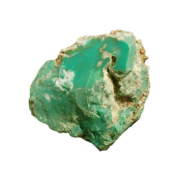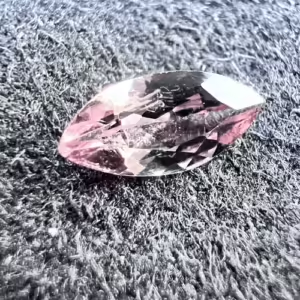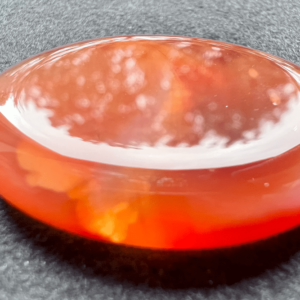Chrysoprase: Properties, Uses and Virtues
Chysoprase: A unique charm
Chrysoprase, a seductive gemstone in shades of vivid green, has been cherished for its captivating charm and distinctive properties throughout the ages.
Associated with healing and tranquility, Chrysoprase has won the admiration of gem enthusiasts and spiritual seekers alike.
Discover the geological formation, historical significance and metaphysical properties of this exquisite crystal.

Chrysoprase: Table of contents
- Chrysoprase Geological Formation
- Rough Chrysoprase – Raw Beauty Revealed
- Sources – The Global Scope of Chrysoprase
- Historical Significance of Chrysoprase – Through the Ages
- Metaphysical Properties of Chrysoprase – Illuminating energies
- Chrysoprase Varieties
- Chrysoprase Colors
- Durability and Wearability of Chrysoprase
- Chrysoprase Enhancements – Preserving Natural Beauty
- Synthetic Chrysoprase – La Nature en Laboratoire
- Imitations of Chrysoprase – Discerning the Authentic
- Chrysoprase Care – Preserving natural beauty
Chrysoprase Geological Formation
Chrysoprase, a variety of chalcedony, and therefore of quartz, is formed in the earth’s crust through a combination of geological processes. It is generally found in silica-rich environments, often associated with volcanic activity and hydrothermal processes.
Chrysoprase’s soothing green hues result from the presence of nickel impurities during its formation. Its journey from mineral solutions to its final crystalline beauty illustrates the remarkable geological forces that shape our planet.
Rough Chrysoprase – Raw Beauty Revealed
As a variety of polycrystalline chalcedony and quartz, Chrysoprase has no specific crystalline form. Its rocky name means that it is composed of many small crystals.
Sources – The Global Scope of Chrysoprase
Chrysoprase is mined in various regions around the world, including Australia, Brazil and the United States. These sources contribute to the gemstone’s range of colors and qualities, making each Chrysoprase unique and captivating in its own way.
Historical Significance of Chrysoprase – Through the Ages
Chrysoprase, with its captivating green hues reminiscent of lush landscapes, has played an important role in the history and cultures of various civilizations. Throughout the ages, this verdant gemstone has been revered for its soothing energies, healing properties and symbolic meanings.
Ancient civilizations :
Chrysoprase’s historical importance dates back to ancient civilizations, where its serene green color was associated with nature and renewal. In ancient Egypt, Chrysoprase was cherished for its link with Maat, the goddess of truth and harmony. It was believed to bring protection and alignment of the heart with universal truths. The Egyptians often used Chrysoprase in jewelry and amulets, considering it a powerful talisman capable of warding off negativity and promoting inner harmony.
Greco-Roman era:
During the Greco-Roman era, Chrysoprase was highly prized for its aesthetic and spiritual qualities. The name “Chrysoprase” comes from the Greek words “chrysos” meaning “gold” and “prason” meaning “leek”, reflecting the stone’s vibrant green color. The ancient Greeks and Romans believed that wearing Chrysoprase could foster a strong connection with nature and bring tranquility to the wearer’s mind and soul. Chrysoprase was also associated with fertility, growth and the abundant energies of spring.
Middle Ages and Renaissance :
In the Middle Ages, Chrysoprase continued to be valued for its unique properties. The color of the stone was often linked to the lushness of the Earth and the promise of new beginnings. It was believed to symbolize hope, rebirth and the eternal cycle of life. Chrysoprase adorned religious objects, ornate jewelry and even medieval manuscripts as a symbol of vitality and renewal.
19th century and beyond :
Chrysoprase enjoyed a resurgence in popularity in the 19th century, becoming a prized gemstone for Victorian jewelry enthusiasts. Its soothing green color was associated with the heart chakra and emotional balance. Chrysoprase was incorporated into jewelry designs, often combined with other gemstones to create complex and meaningful pieces. It was also used in cameos and intaglios, highlighting its captivating color and symbolism.
Metaphysical Properties of Chrysoprase – Illuminating energies
Chrysoprase is considered a stone of harmony and balance, believed to enhance feelings of calm and well-being. It is said to promote inner peace and personal growth, enabling individuals to release negative emotions and adopt a tranquil state of mind.
Chrysoprase’s soothing energies are said to resonate with the heart chakra, promoting love, compassion and forgiveness.
Chrysoprase Varieties
Chrysoprase presents a light range of colors, notably with lemon chrysoprase, which shows subtle green to yellow hues.
Chrysoprase Colors
Chrysoprase captivates with its lush shades of green, from pale pastels to rich, vivid greens. Its colors evoke images of vibrant landscapes and the soothing envelopment of nature. The verdant elegance of the stone is reminiscent of the soothing, regenerative energy associated with Chrysoprase.
Not to be confused with Prase, another variety of chalcedony with a deeper, darker green color.
Durability and Wearability of Chrysoprase
Chrysoprase is highly durable, with a hardness of between 6.5 and 7 on the Mohs scale. This level of hardness ensures that Chrysoprase is suitable for a variety of jewelry designs, and can withstand the rigors of everyday wear while preserving its enduring beauty.
Chrysoprase Enhancements – Preserving Natural Beauty
Chrysoprase is often treated to enhance its color and luster. Heat treatments can intensify its green hues, enhancing its appearance while preserving its natural properties.
Synthetic Chrysoprase – La Nature en Laboratoire
Synthetic Chrysoprase exists, but is rarely found on the market. It is more common to find imitation chrysoprases than synthetic stones.
Imitations of Chrysoprase – Discerning the Authentic
To ensure the authenticity of Chrysoprase, buyers should beware of imitations that attempt to reproduce its vibrant green hues.
Tinted chalcedonies or other green stones may be presented as Chrysoprase, underlining the importance of buying from reputable and competent sources.
However, it should be noted that Chrysoprase itself is often used as an imitation of more precious and rare materials, such as imperial jade, a translucent, pure green jadeite that can cost more than diamonds.
Chrysoprase Care – Preserving natural beauty
To preserve the lasting beauty of Chrysoprase, it is essential to handle it with care. Protect it from aggressive chemicals and store it separately from other gemstones to avoid scratches.
Clean Chrysoprase jewelry gently with a mild soap solution and a soft brush, taking care to preserve its tranquil allure.



Leave a Reply
Want to join the discussion?Feel free to contribute!